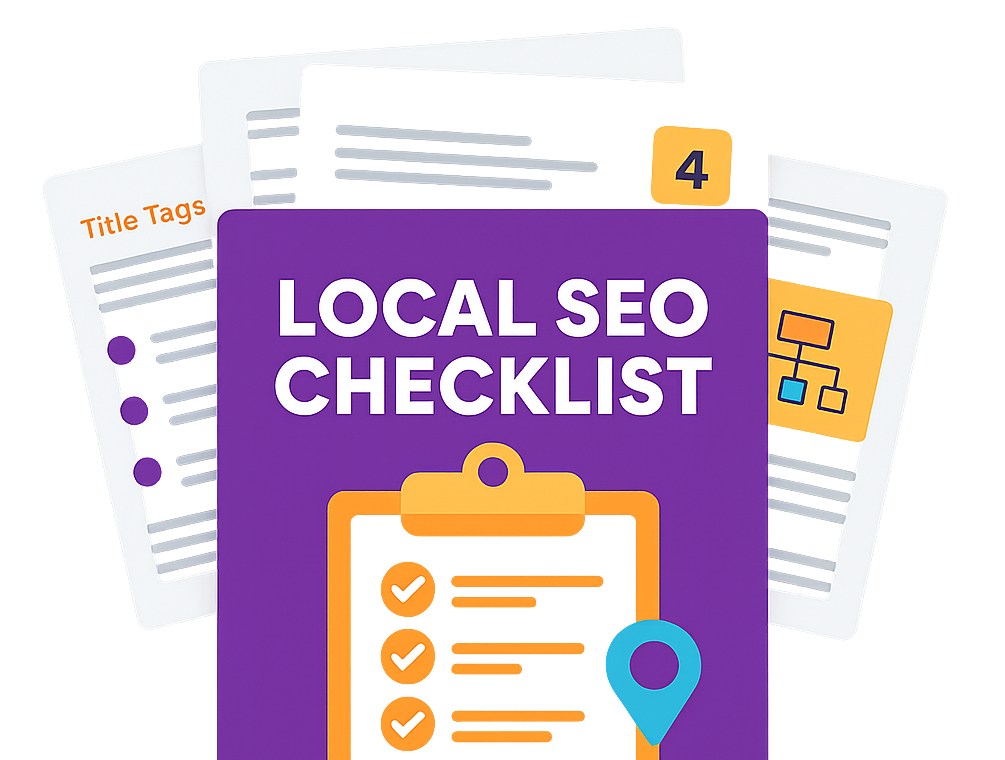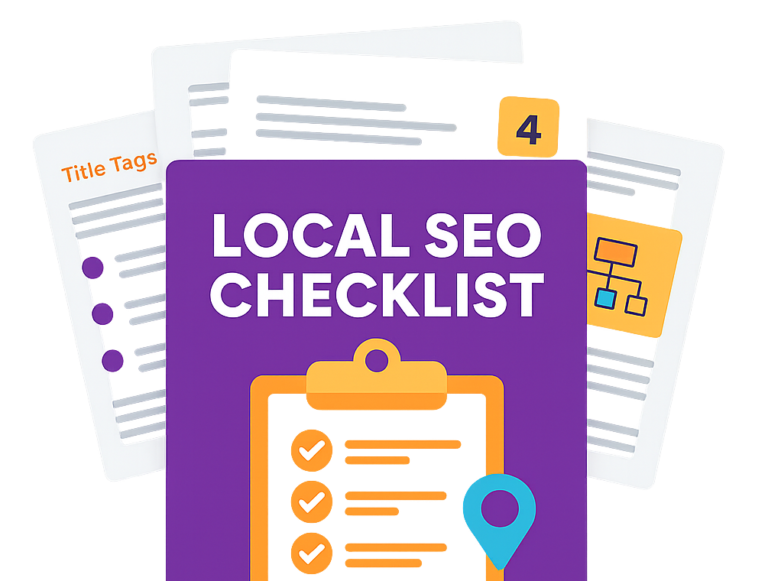To really get competitor analysis right, you have to start with a clear plan. It's not just about snooping on your rivals; it’s about systematically figuring out what they're doing, why it's working (or not), and then using those insights to sharpen your own strategy. This means looking at everything from their pricing and marketing campaigns to what their customers are saying in reviews.
Your Starting Point for Effective Competitor Analysis
Jumping into competitor analysis without a clear goal is like setting sail without a map. You'll gather tons of data, but you won't know what to do with it. This is a foundational process, and the insights you uncover will shape your marketing messages, product roadmap, pricing, and how you position yourself in the market.
This first stage is all about setting a direction. A well-defined objective is your best defence against "analysis paralysis"—that all-too-common trap where you collect endless information but never actually act on it. Before you even think about tools or data points, the first question you should always ask is: "What do we actually want to achieve with this?"
This infographic breaks down why having clear objectives from the get-go is the only way to build a successful competitor analysis framework.

Starting with a clear purpose ensures every step you take is focused and meaningful. It stops you from wasting time on data that doesn't matter.
Before we dive into the nitty-gritty, it helps to see the big picture. Here’s a quick overview of the entire process, which we'll be exploring step-by-step.
The Core Framework of Competitor Analysis
| Stage | Objective | Key Activity |
|---|---|---|
| 1. Define Objectives | Establish what you want to learn and achieve. | Set specific goals for marketing, product, or pricing improvements. |
| 2. Identify Competitors | Determine who you are truly competing against. | Categorise rivals as direct, indirect, and aspirational. |
| 3. Gather Data | Collect relevant information about your competitors. | Analyse their website, SEO, content, social media, and customer reviews. |
| 4. Analyse & Synthesise | Turn raw data into actionable insights. | Use frameworks like SWOT analysis to spot patterns and opportunities. |
| 5. Take Action | Implement changes based on your findings. | Create a strategic plan to improve your business performance. |
This framework provides a solid roadmap, ensuring your analysis is structured, insightful, and leads to real business growth.
Setting Clear Objectives
Your goals will dictate the entire scope of your research. Are you a startup trying to find a gap in the market? Or are you an established player looking to fine-tune your search engine optimisation (SEO) strategy? The answer changes everything.
Here are a few common objectives to get you thinking:
- Refining Your Marketing Strategy: You might want to figure out which channels your competitors are winning on, what type of content their audience loves, and how you can make your own messaging stand out.
- Improving Your Product or Service: The aim here is to spot feature gaps, find out what frustrates customers about rival products, or uncover innovations you could introduce to get an edge.
- Optimising Your Pricing Model: Looking at how competitors price their offerings can tell you if you're positioned correctly. Are you leaving money on the table, or are you charging too much for what you deliver?
- Identifying Market Opportunities: A really thorough analysis might reveal underserved customer groups or emerging trends that your competitors have completely missed.
By setting a specific goal, like 'identify weaknesses in our top three competitors' customer service,' you turn a vague research project into a targeted mission. This focus is what separates insightful analysis from just collecting data.
Ultimately, a precise aim stops you from getting lost in a sea of information. It gives you a lens to view everything through, making it far easier to spot what truly matters and turn those findings into a decisive action plan that gives your business a real competitive advantage.
Identifying Your True Competitors in the UK Market
Before you can even think about analysing the competition, you need a crystal-clear picture of who you're actually up against. It's easy enough to point to the business down the road that sells the same thing, but your real competitive landscape is almost always far more complex than that. A proper analysis means looking beyond the obvious to uncover rivals you might not even realise are eating into your market share.

So many businesses operate with zero competitor visibility, and frankly, it leaves them vulnerable. The trick is to start thinking like your customer. If your product or service vanished tomorrow, where would they spend their money instead? The answer to that simple question reveals your true competitive set.
Looking Beyond the Obvious Rivals
To build a really useful competitor map, you have to categorise them. This simple act of organisation is what helps you prioritise your efforts and understand the different threats and opportunities each group presents. It’s a foundational step that many people skip.
I always break competitors down into three main categories:
- Direct Competitors: These are the most straightforward. They sell a near-identical product or service to the same target audience in your geographical patch. For a local bakery in Cambridge, another independent bakery just around the corner is a direct competitor. No surprises there.
- Indirect Competitors: This is where it gets interesting. These businesses solve the same customer problem but with a completely different solution. For that same Cambridge bakery, an indirect competitor could be a local café that sells pastries, a big supermarket like Tesco with an in-store bakery, or even a meal-prep service offering healthy breakfast options. They are all fighting for the customer’s breakfast budget.
- Emerging or 'Disruptor' Competitors: These are the new kids on the block, often moving fast and using innovative tactics that could completely shift the market. Think of a new online-only bakery that offers nationwide delivery, built entirely on a viral TikTok campaign. They have a knack for finding underserved markets and can grab attention almost overnight.
By mapping out all three types, you get a much more realistic view of the market. Ignoring indirect or emerging players is a classic mistake that can leave your business wide open to unexpected challenges.
A common mistake is to focus solely on direct competitors. In reality, customers have a finite budget, and indirect competitors are often vying for the exact same share of your customer's wallet, just with a different value proposition.
Practical Methods for Identifying UK Competitors
So, how do you actually find these competitors without just guessing? Forget a quick Google search; that will only scratch the surface. You need to dig deeper using a combination of tools and research methods designed for the UK market.
Start by getting into your customer's mindset. Search for your product or service using the exact phrases they would use. Which businesses pop up on the first page of Google? Who is running Google Ads for those terms? These are your primary digital rivals, right there.
From there, broaden your search with these practical steps:
- Analyse Customer Feedback: Go through your own customer reviews and surveys. What other companies or products do they mention? This is an absolute goldmine for discovering who your customers were considering before they chose you.
- Explore Industry Reports and Publications: UK market research reports from firms like Mintel or YouGov often list key players and market share data. Publications specific to your industry will also feature articles and interviews that reveal who the established leaders and rising stars are.
- Use Digital Tools: Tools like Ahrefs or SEMrush are brilliant for showing you who is competing for your target keywords in organic search. A tool like Similarweb can give you a peek at website traffic, revealing other sites your audience frequently visits.
- Check Companies House: A quick search on the Companies House register can uncover details about UK-based private companies. It gives you a sense of their financial health and scale, even if they aren't publicly listed.
Once you have a solid list of around seven to ten varied competitors, you can begin to organise them. This creates a solid foundation, ensuring your analysis is based on a realistic and comprehensive understanding of the competitive environment. This process transforms your analysis from a simple comparison into a powerful strategic tool.
Gathering Actionable Intelligence on Your Rivals
Okay, you’ve got your list of competitors. Now the real work begins. It’s time to roll up your sleeves and shift from simply knowing who they are to understanding how they operate. This is the deep-dive phase where we gather the raw data that will actually inform your strategy.
Effective intelligence gathering isn't about hoarding every piece of information you can find. It’s about being selective and focusing on the metrics that genuinely move the needle for your business goals.

We're going to build a 360-degree view, looking at everything from their digital footprint and customer sentiment right through to their financial stability. The goal is to paint a detailed, evidence-based picture of their operations, their strengths, and most importantly, their weaknesses.
Analysing Their Digital Presence
A competitor's website is their digital shop window, and it's absolutely packed with intelligence. Your first port of call should be a thorough teardown of their site’s structure, content, and overall performance. Look past the flashy design and get into the meat of what they offer and how they talk about it.
Next, you need to get forensic about their search engine optimisation (SEO) strategy. What keywords are they actually ranking for? What kind of content are they creating to pull in organic traffic? Tools like Ahrefs or SEMrush are indispensable here. They’ll show you top-performing pages, backlink profiles, and even their paid search campaigns. This stuff tells you exactly where they’re putting their marketing budget and what topics are hitting the mark with your shared audience.
Finally, put their social media activity under the microscope. It’s not about vanity metrics like follower counts. You need to dig deeper:
- Engagement Rates: What's the average number of likes, comments, and shares per post? High engagement is a sign of a genuinely active and loyal community.
- Content Themes: What are the core topics they post about? Is it all promotional, or are they providing educational, community-focused content?
- Customer Interaction: How do they handle comments and questions? Quick, helpful replies suggest they have their customer service dialled in.
- Advertising: Most platforms have transparency tools that let you see the ads a page is running. This is a direct window into their campaign messaging and targeting.
Scrutinising Pricing and Customer Feedback
Getting a handle on a competitor's pricing model is fundamental. Is it all laid out transparently on their site, or is it hidden behind a "contact us for a quote" wall? That little detail can tell you a lot—the latter often points to a more bespoke or high-ticket service. Make sure you document their pricing tiers, the features included at each level, and any promotions they’re running.
But price is only half the story. Customer reviews tell the other half.
Platforms like Trustpilot, Google Reviews, and niche industry forums are absolute goldmines of honest, unfiltered feedback. Don't just glance at the star ratings; you need to read the comments.
Customer reviews offer an unfiltered look into a competitor's operational reality. Recurring complaints about poor delivery, confusing software, or unresponsive support highlight exploitable weaknesses in their service.
This is where you find out what customers really care about and where your rivals are dropping the ball. These are powerful opportunities for you to differentiate by simply being better where it counts.
Before we dive into their financials, let's pull all this together. A checklist can be a massive help in keeping your data collection organised.
Competitor Data Collection Checklist
Here’s a practical checklist to guide your intelligence-gathering efforts, ensuring you cover all the essential bases.
| Category | Data Point to Collect | Recommended Tool(s) |
|---|---|---|
| Website & SEO | Top Ranking Keywords & Pages | Ahrefs, SEMrush, Moz |
| Backlink Profile Quality | Ahrefs, Majestic | |
| Website Traffic Estimates | Similarweb, Ahrefs | |
| Core Web Vitals & Site Speed | Google PageSpeed Insights | |
| Content | Blog Topics & Formats | BuzzSumo, SEMrush |
| Content Update Frequency | Manual check, Ahrefs | |
| Social Media Content Themes | Manual review, Sprout Social | |
| Social Media | Engagement Rate (Likes, Shares) | Phlanx, Manual calculation |
| Follower Growth Over Time | SocialBlade | |
| Ad Campaigns & Messaging | Facebook Ad Library | |
| Pricing & Product | Pricing Tiers & Features | Competitor's website |
| Discounts & Promotions | Manual check, newsletters | |
| Customer Reviews & Complaints | Trustpilot, Google Reviews | |
| Financials | Annual Turnover & Profitability | Companies House (UK), Public filings |
| Funding Rounds & Investments | Crunchbase, PitchBook |
This checklist isn't exhaustive, but it provides a solid framework to make sure you’re gathering structured, comparable data that you can actually use.
Looking at the Financial Picture
For a much deeper understanding of a competitor's scale and stability, you have to look at their financial health, where possible. This is easy for publicly traded companies. For private limited companies in the UK, Companies House is your friend, offering free access to annual accounts. This gives you a snapshot of their turnover, profitability, and overall financial direction.
Financial data adds crucial context to a competitor's strategic moves. Are they flush with cash and likely to invest heavily in growth, or are their finances looking a bit shaky, suggesting they might pull back on marketing or innovation? This helps you gauge their potential for making aggressive market plays. If you need to pull lots of structured information from websites or public records, using an instant data scraper can save a huge amount of time.
Public financial benchmarks are also vital for understanding your rivals’ scale and market confidence. For example, in 2025, the UK’s most valuable company by market capitalisation was AstraZeneca, with a valuation of £186.59 billion—more than 10% higher than the second-placed Linde. That kind of gap shows how direct financial comparison is vital, especially where specific milestones can drastically change a company's valuation. You can find more insights like this from UK business statistics. This level of financial analysis helps you realistically benchmark your own performance and ambitions against the market leaders.
Turning Your Data into Strategic Insights
You’ve done the hard work of gathering the data. Now for the most important part: turning all that raw information into a real strategic advantage. On its own, a spreadsheet full of facts is just noise. The real magic happens during interpretation, where you connect the dots to find opportunities and threats that will shape your next move.
The goal here is to dig deeper than surface-level observations. You need to start asking why. Why does one competitor’s blog content get so many shares? Why did another’s latest marketing campaign completely flop? Asking these questions is how you start to understand the mechanics behind their wins and losses.
Applying a Strategic Framework to Cut Through the Noise
One of the best ways to bring structure to your analysis is by using a tried-and-tested framework. The SWOT analysis—Strengths, Weaknesses, Opportunities, and Threats—is a classic for a good reason. But its true power is unlocked when you apply it to your competitors, not just yourself.
For each key rival, sort your findings into these four categories:
- Strengths: What are they genuinely brilliant at? Maybe it's their powerful brand recognition, a super-efficient supply chain, or fiercely loyal customers.
- Weaknesses: Where are they fumbling? Look for patterns in customer complaints, a clunky website experience, or a glaring gap in their product line-up.
- Opportunities: Based on their weaknesses, where can you swoop in? Their terrible customer service could be your chance to become known for outstanding support.
- Threats: What are they doing that could hurt your business? This might be a planned expansion into your turf or a new product launch that directly competes with your best-seller.
This disciplined approach forces you to organise your intel, making it much easier to see the bigger picture and decide what to tackle first.
Spotting Your Competitors’ Patterns of Behaviour
Beyond a static analysis, the real art is spotting patterns over time. Businesses, just like people, fall into predictable habits. If you can learn to spot these recurring behaviours, you’ll gain a powerful predictive edge.
Start looking for triggers and responses. Do they always launch a big sale the week before a bank holiday? Do they churn out a load of new blog posts right after a major Google algorithm update? These patterns effectively reveal their operational playbook.
Understanding a competitor's behavioural patterns lets you shift from a reactive to a proactive stance. If you know they discount certain products every quarter, you can prepare a counter-offer or a marketing campaign to neutralise their advantage before it even happens.
This kind of insight is gold for strategic planning. It helps you anticipate their moves, prepare your responses, and even get ahead of their campaigns, turning their predictability into your competitive advantage. For a deeper dive, especially if you're in the SaaS space, exploring specific methods for a SaaS Competitive Analysis can sharpen your approach.
Uncovering Market Gaps and Your Unique Strengths
The final piece of the puzzle is to hold all these findings up against your own performance. This is where you identify the most fertile ground for growth. A side-by-side comparison will throw market gaps and your unique selling propositions (USPs) into sharp relief.
For example, a small e-commerce business might discover that its huge rival, despite an enormous product range, has consistently awful reviews about delivery times. This weakness represents a clear market gap. The smaller business can then double down on its own logistics, positioning itself as the reliable, fast-shipping alternative. Just like that, a competitor's weakness is transformed into a core strength.
It's also crucial to understand the wider business climate. According to the Office for National Statistics, nearly two-thirds (65%) of UK businesses reported some form of concern for their business looking ahead to March 2025. Competition was a key worry, but so were falling demand and taxation. For instance, 24% of businesses in the hyper-competitive wholesale and retail trade cited falling demand as their main concern, suggesting rivals might be gearing up for price wars or aggressive marketing pushes.
This context helps you interpret your competitors' potential moves with greater accuracy. By systematically analysing your data, you stop guessing and start making evidence-based decisions, ensuring your strategy is built on the solid foundation of market reality.
Turning Your Analysis Into a Winning Business Strategy
Right, you’ve done the hard graft and collected a mountain of competitor data. But let’s be honest, data is just data until you do something with it. An analysis that sits gathering digital dust on a server is a massive wasted opportunity.
This is where the real work begins. The final, and most critical, part of this process is translating all those hard-won insights into tangible actions that move your business forward. We’re shifting from observation to execution. The goal isn’t just to play catch-up with what your rivals are doing now; it’s about anticipating their next moves and building a dynamic strategy that keeps you one step ahead.
It's all about being proactive, not just reactive.
Prioritising Opportunities and Threats
You’re probably looking at a long list of potential actions right now. Don't panic. You can't do everything at once, and you shouldn't even try.
The first step is to prioritise. A simple but incredibly effective way to do this is by mapping your findings on an impact/effort matrix. This little exercise is brilliant for sorting the quick wins from the long-term strategic projects.
For every insight you’ve uncovered, ask yourself two simple questions:
- What’s the potential impact on our business? (Think big – like capturing a whole new customer segment).
- How much effort is required to actually do it? (This could be as simple as tweaking some website copy).
This straightforward approach helps you focus your time and money where they’ll deliver the biggest bang for your buck. For instance, imagine you discover a major competitor has consistently terrible customer reviews about their delivery times (high impact). If you know you can quickly improve your own logistics (low effort), that’s a top-priority action. Jump on it.
Refining Your Marketing and Sales Approach
Your competitor intelligence is an absolute goldmine for sharpening your marketing message.
Did you find out your rivals are completely ignoring a specific demographic you know is a perfect fit for your product? That’s a clear signal to adjust your ad campaigns and content to speak directly to that underserved audience.
Competitor analysis should directly shape your value proposition. If every rival is in a race to the bottom on price, your best move might be to zig while they zag. Focus on superior quality, exceptional customer service, or faster delivery—and make sure you shout about it in your marketing.
Take a local Cambridgeshire plumber, for example. They might find that their main competitors focus all their advertising on emergency call-outs. By analysing this, they could decide to build their marketing strategy around pre-planned, high-value installation projects instead. Just like that, they’ve carved out a less competitive and more profitable niche.
Innovating Your Product and Service Offerings
Want one of the fastest routes to innovation? Start digging into your competitors' product weaknesses. Customer reviews are your best friend here.
If you keep seeing repeated complaints about a missing feature in a rival's product, you’ve just been handed a clear, validated idea for your own development roadmap.
This doesn't always mean piling on more features, though. Sometimes, the real opportunity is in simplification. If competitors are offering overly complex and expensive solutions, a more streamlined, cost-effective alternative could swoop in and win a huge chunk of the market. It all comes down to using the data to solve a customer problem better than anyone else.
Case Study: A Local E-commerce Success
A small, UK-based online retailer selling handmade leather goods noticed their larger competitors had thousands of products but slow, impersonal customer service. They used this single insight to build their entire strategy around a personalised experience.
They started offering customisation options, sent handwritten thank-you notes with every order, and made sure a real person answered every customer email within the hour.
Their competitor analysis revealed that in a crowded market, brilliant service was a more powerful differentiator than a massive product catalogue. This intense focus allowed them to build a fiercely loyal customer base and achieve a 35% year-on-year growth in repeat purchases. Developing a strong strategy often requires a deep understanding of the digital landscape, which is where a specialist SEO agency like Bare Digital can provide essential support.
Ultimately, your analysis should be a living, breathing document. The market will change, new competitors will pop up, and customer preferences will evolve. By embedding competitor analysis into your regular strategic planning, you create a business that doesn't just survive—it thrives.
Common Questions About Competitor Analysis
Even with a solid game plan, you're bound to run into questions once you start digging into your competitors' business. This is where the real work begins, and a few common queries always seem to pop up.
Think of this section as a quick-fire Q&A to help you iron out the wrinkles in your process and make sure you're getting genuine value from your efforts.
How Often Should I Run a Competitor Analysis?
There’s no magic number here, but a good rhythm is to schedule a deep-dive analysis at least once a year. This is your comprehensive MOT, covering everything from SEO performance to their financial health, giving you that crucial big-picture view.
But the market moves fast, and you can’t afford to wait a full year between check-ups. For the more agile parts of their strategy—think marketing campaigns, social media blitzes, or sudden price changes—a quarterly check-in is a smart baseline.
If you’re in a fast-paced industry like e-commerce or tech, you'll need to be even more nimble. The main thing is to treat competitor analysis as an ongoing business function, not a one-off report that gathers dust in a forgotten folder.
What Are the Biggest Mistakes People Make?
It’s surprisingly easy to fall into a few common traps. Knowing what they are from the outset can save you a world of pain and wasted time.
Here are the pitfalls I see most often:
- Analysis Paralysis: This is the big one. It’s when you get so bogged down gathering data that you never actually do anything with it. Remember, the goal isn't just to know stuff; it's to act on what you learn.
- Only Watching Your Direct Rivals: It’s a classic error to obsess over the competitor you share an office block with while ignoring the up-and-coming disruptor who’s solving the same problem in a totally new way.
- Relying on a Single Source of Truth: Don’t hang your entire strategy on one metric, like website traffic from a single tool. A proper analysis blends hard data (like traffic stats) with qualitative insights (like what real customers are saying on Trustpilot).
- Playing Copycat: The point is to understand your rivals' playbook so you can find your own unique advantage, not become a cheap imitation. Use their wins and losses as inspiration to innovate, not just imitate.
Which Free Tools Are Best for a UK Business Just Starting Out?
You absolutely don't need a massive budget to get started. For a UK business keeping a close eye on the purse strings, there are some brilliant free tools that can paint a surprisingly detailed picture.
First off, Google Alerts is non-negotiable. Set it up to track mentions of your competitors across the web—it's simple but effective. For a high-level look at website traffic and audience demographics, the free versions of tools like Similarweb are fantastic.
Want to know what questions your shared audience is asking online? AnswerThePublic is your secret weapon for brainstorming content ideas. For social media, you can learn a huge amount just by following your competitors' profiles and using native platform features, like the Facebook Ad Library, to see exactly what ads they're running.
Honestly, a well-organised manual review combined with these free tools will get you 80% of the way there. The secret is knowing what to look for and being consistent.
How Do I Analyse a Private Company?
Analysing a private limited company in the UK takes a bit more detective work, but it’s far from impossible. There’s a wealth of publicly available information that can give you a very clear picture of their strategy.
Your first port of call should always be Companies House. Here, you can access their annual accounts and confirmation statements for free. This gives you hard facts on their financial health, who the directors are, and where they're officially based. It’s a goldmine for understanding their scale and stability.
After that, switch your focus to their public-facing activities. Get forensic with their website content, SEO strategy, and even their job postings—the roles they’re hiring for are a massive clue about where they're investing. Scour their customer reviews on sites like Trustpilot, dissect their press releases for new initiatives, and see which industry events they’re speaking at. It all comes together to build a robust profile without needing public market data.
At Bare Digital, we know that sharp, ongoing competitor analysis is the foundation of any SEO strategy that actually works. By understanding where your rivals are winning and losing, we can uncover those untapped opportunities to get you ranking higher and converting more. Ready to turn insights into impact? Get your free, no-obligation SEO proposal today.








